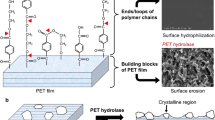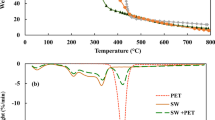Abstract
The restricted bioavailability of structurally complex carbohydrates for digestion has hitherto resulted in a low methane potential from rubber wood waste (RW). The effects of hydrothermal (HT) and ethanol organosolv (OS) pretreatments on the methane produced by anaerobic digestion of RW were investigated in the study reported. HT with temperatures above 190 °C significantly enhanced the anaerobic digestibility of RW mainly due to the degradation of hemicellulose. On the other hand, OS with 75% ethanol provided a potential methane gas yield of 165.1 L CH4/kg-VS, which was higher than that for HT at 210 and 230 °C by 39 and 7%, respectively. This was due to intensive delignification during OS pretreatment which led to a reduction in the non-productive adsorption of cellulolytic enzymes by lignin. A first-order kinetic model showed that OS had a higher hydrolysis rate (k = 0.073 ± 0.003 day−1) resulting in a higher methane yield when lower pretreatment temperatures were applied. The anaerobic degradation of the pretreated RW in this study was a result of simultaneous CH4 production through the symbiosis of anaerobic bacteria and methanogens using a combination of the aceticlastic and hydrogenothrophic bioconversion pathways. The recovery and use of the phenolic compounds remaining in the process water would be a way of adding value to this process and the feasibility of producing methane from RW should be further investigated.







Similar content being viewed by others
Data availability
The data supporting the findings of this study are available within the article (and/or) its supplementary materials.
References
Li ZY, Wang YT, Guo ST, Li ZX, Xing YR, Liu GQ, Fang R, Hu Y, Zhu HT, Yan YL (2019) PM2.5 associated PAHs and inorganic elements from combustion of biomass, cable wrapping, domestic waste, and garbage for power generation. Aerosol Air Qual Res 19(11):2502–2517. https://doi.org/10.4209/aaqr.2019.10.0495
Maschowski C, Kruspan P, Garra P, Talib Arif A, Trouvé G, Gieré R (2019) Physicochemical and mineralogical characterization of biomass ash from different power plants in the Upper Rhine Region. Fuel 258:116020. https://doi.org/10.1016/j.fuel.2019.116020
Eom T, Chaiprapat S, Charnnok B (2019) Enhanced enzymatic hydrolysis and methane production from rubber wood waste using steam explosion. J Environ Manag 235:231–239. https://doi.org/10.1016/j.jenvman.2019.01.041
Inkrod C, Raita M, Champreda V, Laosiripojana N (2018) Characteristics of lignin extracted from different lignocellulosic materials via organosolv fractionation. Bioenergy Res 11(2):277–290. https://doi.org/10.1007/s12155-018-9895-2
Charnnok B, Sawangkeaw R, Chaiprapat S (2020) Integrated process for the production of fermentable sugar and methane from rubber wood. Bioresour Technol 302:122785. https://doi.org/10.1016/j.biortech.2020.122785
Giummarella N, Pu Y, Ragauskas AJ, Lawoko M (2019) A critical review on the analysis of lignin carbohydrate bonds. Green Chem 21(7):1573–1595. https://doi.org/10.1039/C8GC03606C
Charnnok B, Sakdaronnarong C, Sinbuathong N (2019) Hydrothermal pretreatment with sulfonated bentonite catalyst enhances potassium removal and bioconversion of oil palm empty fruit bunch to sugar and biohydrogen. Biomass Conversion Biorefinery 9(2):389–399. https://doi.org/10.1007/s13399-018-0360-4
Cao Y, Chen SS, Zhang S, Ok YS, Matsagar BM, Wu KCW, Tsang DCW (2019) Advances in lignin valorization towards bio-based chemicals and fuels: lignin biorefinery. Bioresour Technol 291:121878. https://doi.org/10.1016/j.biortech.2019.121878
Schutyser W, Renders T, Van den Bosch S, Koelewijn SF, Beckham GT, Sels BF (2018) Chemicals from lignin: an interplay of lignocellulose fractionation, depolymerisation, and upgrading. Chem Soc Rev 47(3):852–908. https://doi.org/10.1039/C7CS00566K
Khan MU, Ahring BK (2019) Lignin degradation under anaerobic digestion: influence of lignin modifications -a review. Biomass Bioenergy 128:105325. https://doi.org/10.1016/j.biombioe.2019.105325
Mancini G, Papirio S, Lens PNL, Esposito G (2018) Anaerobic digestion of lignocellulosic materials using ethanol-organosolv pretreatment. Environ Eng Sci 35(9):953–960. https://doi.org/10.1089/ees.2018.0042
Mancini G, Papirio S, Lens PNL, Esposito G (2018) Increased biogas production from wheat straw by chemical pretreatments. Renew Energy 119:608–614. https://doi.org/10.1016/j.renene.2017.12.045
Schuerch C (1952) The solvent properties of liquids and their relation to the solubility, swelling, isolation and fractionation of lignin. J Am Chem Soc 74(20):5061–5067. https://doi.org/10.1021/ja01140a020
Zhao X, Li S, Wu R, Liu D (2017) Organosolv fractionating pre-treatment of lignocellulosic biomass for efficient enzymatic saccharification: chemistry, kinetics, and substrate structures. Biofuels Bioprod Biorefin 11(3):567–590. https://doi.org/10.1002/bbb.1768
Mancini G, Papirio S, Lens PNL, Esposito G (2016) Solvent pretreatments of lignocellulosic materials to enhance biogas production: a review. Energy Fuel 30(3):1892–1903. https://doi.org/10.1021/acs.energyfuels.5b02711
Mustafa AM, Li H, Radwan AA, Sheng K, Chen X (2018) Effect of hydrothermal and Ca(OH)2 pretreatments on anaerobic digestion of sugarcane bagasse for biogas production. Bioresour Technol 259:54–60. https://doi.org/10.1016/j.biortech.2018.03.028
Adney B, Baker J (2008) Measurement of cellulase activities laboratory analytical procedure (LAP) (technical report NREL/TP-510-42628 January 2008). National Renewable Energy Laboratory (NREL)
Miller GL (1959) Use of dinitrosalicylic acid reagent for determination of reducing sugar. Anal Chem 31(3):426–428. https://doi.org/10.1021/ac60147a030
Raposo F, Banks CJ, Siegert I, Heaven S, Borja R (2006) Influence of inoculum to substrate ratio on the biochemical methane potential of maize in batch tests. Process Biochem 41(6):1444–1450. https://doi.org/10.1016/j.procbio.2006.01.012
Rafique R, Poulsen TG, Nizami A-S, Asam Z-u-Z, Murphy JD, Kiely G (2010) Effect of thermal, chemical and thermo-chemical pre-treatments to enhance methane production. Energy 35(12):4556–4561. https://doi.org/10.1016/j.energy.2010.07.011
Buswell AM, Mueller HF (1952) Mechanism of methane fermentation. Ind Eng Chem 44(3):550–552
Tao X, Zhang P, Zhang G, Nabi M, Wang S, Ye J, Bao S, Zhang Q, Chen N (2019) Carbide slag pretreatment enhances volatile fatty acid production in anaerobic fermentation of four grass biomasses. Energy Convers Manag 199:112009. https://doi.org/10.1016/j.enconman.2019.112009
Muyzer G, Smalla K (1998) Application of denaturing gradient gel electrophoresis (DGGE) and temperature gradient gel electrophoresis (TGGE) in microbial ecology. Antonie Van Leeuwenhoek 73(1):127–141. https://doi.org/10.1023/a:1000669317571
Sluiter A, Hames B, Hyman D, Payne C, Ruiz R, Scarlata C, Sluiter J, Templeton D, Wolfe J (2008) Determination of total solids in biomass and total dissolved solids in liquid process samples. National Renewable Energy Laboratory (NREL)
Sluiter A, Hames B, Ruiz R, Scarlata C, Sluiter J, Templeton D, Crocker D (2008) Determination of structural carbohydrates and lignin in biomass. National Renewable Energy Laboratory (NREL)
Segal L, Creely JJ, Martin AE Jr, Conrad CM (1959) An empirical method for estimating the degree of crystallinity of native cellulose using the X-ray diffractometer. Text Res J 29(10):786–794. https://doi.org/10.1177/004051755902901003
Blainski A, Lopes GC, de Mello JC (2013) Application and analysis of the Folin Ciocalteu method for the determination of the total phenolic content from Limonium brasiliense L. Molecules 18(6):6852–6865. https://doi.org/10.3390/molecules18066852
Ni Y, Hu Q (1995) Alcell® lignin solubility in ethanol–water mixtures. J Appl Polym Sci 57(12):1441–1446. https://doi.org/10.1002/app.1995.070571203
Sun W, Othman MZ (2019) A selective fractionation method of lignocellulosic materials using electro-assisted organosolv pretreatment. Bioresour Technol 288:121421. https://doi.org/10.1016/j.biortech.2019.121421
Kang X, Zhang Y, Li L, Sun Y, Kong X, Yuan Z (2020) Enhanced methane production from anaerobic digestion of hybrid Pennisetum by selectively removing lignin with sodium chlorite. Bioresour Technol 295:122289. https://doi.org/10.1016/j.biortech.2019.122289
Chowdhury ZZ, Krishnan B, Sagadevan S, Rafique FR, Hamizi AN, Abdul Wahab Y, Khan AA, Johan BR, Al-douri Y, Kazi NS, Tawab Shah S (2018) Effect of temperature on the physical, electro-chemical and adsorption properties of carbon micro-spheres using hydrothermal carbonization process. Nanomaterials 8 (8). doi:https://doi.org/10.3390/nano8080597
Trajano HL, Engle NL, Foston M, Ragauskas AJ, Tschaplinski TJ, Wyman CE (2013) The fate of lignin during hydrothermal pretreatment. Biotechnol Biofuels 6(1):110. https://doi.org/10.1186/1754-6834-6-110
Hao X, Li Y, Wang J, Qin Y, Zhang J (2019) Adsorption and desorption of cellulases on/from lignin-rich residues from corn Stover. Ind Crop Prod 139:111559. https://doi.org/10.1016/j.indcrop.2019.111559
Imman S, Laosiripojana N, Champreda V (2018) Effects of liquid hot water pretreatment on enzymatic hydrolysis and physicochemical changes of corncobs. Appl Biochem Biotechnol 184(2):432–443. https://doi.org/10.1007/s12010-017-2541-1
Ghasimi DSM, Aboudi K, de Kreuk M, Zandvoort MH, van Lier JB (2016) Impact of lignocellulosic-waste intermediates on hydrolysis and methanogenesis under thermophilic and mesophilic conditions. Chem Eng J 295:181–191. https://doi.org/10.1016/j.cej.2016.03.045
Buitrón G, Hernández-Juárez A, Hernández-Ramírez MD, Sánchez A (2019) Biochemical methane potential from lignocellulosic wastes hydrothermally pretreated. Ind Crop Prod 139:111555. https://doi.org/10.1016/j.indcrop.2019.111555
Bittencourt GA, Barreto ES, Brandão RL, Baêta BEL, Gurgel LVA (2019) Fractionation of sugarcane bagasse using hydrothermal and advanced oxidative pretreatments for bioethanol and biogas production in lignocellulose biorefineries. Bioresour Technol 292:121963. https://doi.org/10.1016/j.biortech.2019.121963
Choe U, Mustafa AM, Lin H, Choe U, Sheng K (2020) Anaerobic co-digestion of fish processing waste with a liquid fraction of hydrothermal carbonization of bamboo residue. Bioresour Technol 297:122542. https://doi.org/10.1016/j.biortech.2019.122542
Czekała W, Lewicki A, Pochwatka P, Czekała A, Wojcieszak D, Jóźwiakowski K, Waliszewska H (2020) Digestate management in polish farms as an element of the nutrient cycle. J Clean Prod 242:118454. https://doi.org/10.1016/j.jclepro.2019.118454
Shang GY, Zhang CG, Wang F, Qiu L, Guo XH, Xu FQ (2019) Liquid hot water pretreatment to enhance the anaerobic digestion of wheat straw-effects of temperature and retention time. Environ Sci Pollut Res 26(28):29424–29434. https://doi.org/10.1007/s11356-019-06111-z
Suksong W, Kongjan P, Prasertsan P, Imai T, O-Thong S (2016) Optimization and microbial community analysis for production of biogas from solid waste residues of palm oil mill industry by solid-state anaerobic digestion. Bioresour Technol 214:166–174. https://doi.org/10.1016/j.biortech.2016.04.077
Xu XW, Huo YY, Bai XD, Wang CS, Oren A, Li SY, Wu M (2011) Kordiimonas lacus sp. nov., isolated from a ballast water tank, and emended description of the genus Kordiimonas. Int J Syst Evol Microbiol 61(Pt 2):422–426. https://doi.org/10.1099/ijs.0.018200-0
Hattori S (2008) Syntrophic acetate-oxidizing microbes in methanogenic environments. Microbes Environ 23(2):118–127. https://doi.org/10.1264/jsme2.23.118
Guan Y, Ngugi DK, Vinu M, Blom J, Alam I, Guillot S, Ferry JG, Stingl U (2019) Comparative genomics of the genus Methanohalophilus, including a newly isolated strain from Kebrit deep in the Red Sea. Front Microbiol 10:839. https://doi.org/10.3389/fmicb.2019.00839
Tomita H, Okazaki F, Tamaru Y (2019) Biomethane production from sugar beet pulp under cocultivation with Clostridium cellulovorans and methanogens. AMB Express 9(1):28. https://doi.org/10.1186/s13568-019-0752-2
Hattori S, Kamagata Y, Hanada S, Shoun H (2000) Thermacetogenium phaeum gen. nov., sp. nov., a strictly anaerobic, thermophilic, syntrophic acetate-oxidizing bacterium. Int J Syst Evol Microbiol 50(Pt 4):1601–1609. https://doi.org/10.1099/00207713-50-4-1601
Watanabe M, Kojima H, Fukui M (2013) Desulfotomaculum intricatum sp. nov., a sulfate reducer isolated from freshwater lake sediment. Int J Syst Evol Microbiol 63(Pt 10):3574–3578. https://doi.org/10.1099/ijs.0.051854-0
L'Haridon S, Cilia V, Messner P, Raguenes G, Gambacorta A, Sleytr UB, Prieur D, Jeanthon C (1998) Desulfurobacterium thermolithotrophum gen. nov., sp. nov., a novel autotrophic, sulphur-reducing bacterium isolated from a deep-sea hydrothermal vent. Int J Syst Bacteriol 48(Pt 3):701–711. https://doi.org/10.1099/00207713-48-3-701
Farghali M, Andriamanohiarisoamanana FJ, Ahmed MM, Kotb S, Yamashiro T, Iwasaki M, Umetsu K (2019) Impacts of iron oxide and titanium dioxide nanoparticles on biogas production: hydrogen sulfide mitigation, process stability, and prospective challenges. J Environ Manag 240:160–167. https://doi.org/10.1016/j.jenvman.2019.03.089
Acknowledgments
This research was financially supported by the National Rubber Innovation Research Institute, Prince of Songkla University contract no. ENG590476S as well as by the Interdisciplinary Graduate School of Energy Systems and the Graduate School of Prince of Songkla University, Thailand. The authors would like to thank Panel Plus Co. Ltd. for rubber wood waste and Chalong Latex Industry Co., Ltd. Songkhla, Thailand, for the anaerobic inoculum. The authors would also like to recognize the support of the Energy Technology Research Center and Environmental Laboratory, Faculty of Environmental Management, Prince of Songkla University as well as the Department of Mathematics and Statistics, Faculty of Science, Prince of Songkla University for statistical analysis. We also acknowledge the Publication Clinic, Research and Development Office, PSU, for help in manuscript proofreading.
Funding
(1) National Rubber Innovation Research Institute, Prince of Songkla University contract no. ENG590476S, (2) The Interdisciplinary Graduate School of Energy Systems, and (3) The Graduate School of Prince of Songkla University, Thailand.
Author information
Authors and Affiliations
Contributions
Tanate Tongbuekeaw (Carried out the experiment, acquisition of data, analysis and interpretation of data and drafting of manuscript).
Ruengwit Sawangkeaw (Carried out the experiment and acquisition of data).
Sumate Chaiprapat (Contributed to the design and implementation of the research).
Boonya Charnnokd (Directed the project, study conception and design, analysis and interpretation of data, the drafting of the manuscript; contributed to the final version of the manuscript).
Corresponding author
Ethics declarations
Conflict of interest
The authors declare that they have no conflict of interest.
Additional information
Publisher’s Note
Springer Nature remains neutral with regard to jurisdictional claims in published maps and institutional affiliations.
Electronic supplementary material
ESM 1
(PDF 319 kb)
Rights and permissions
About this article
Cite this article
Tongbuekeaw, T., Sawangkeaw, R., Chaiprapat, S. et al. Conversion of rubber wood waste to methane by ethanol organosolv pretreatment. Biomass Conv. Bioref. 11, 999–1011 (2021). https://doi.org/10.1007/s13399-020-00710-4
Received:
Revised:
Accepted:
Published:
Issue Date:
DOI: https://doi.org/10.1007/s13399-020-00710-4




